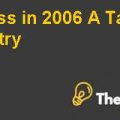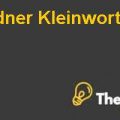
Introduction and Problem Situation:
Simon Property Group is considered as the largest mall owner in North America. It has 300 malls including those in Europe and Japan. Moreover, it has an equity valuation of $ 6.5 billion. However, it has surpassed the performance of its competitors by carrying out large deals such as those relating to DeBartolo Realty Corp. of $ 3 billion and various other transactions. These transactions have enabled it to increase its net operating profit and hence, have made it one of the best competitors in the REIT Industry.
Being known for acquiring attractive Real Estate Investment Trusts (REIT), SPG wants to set its sight on Taubman Centre which is a prominent property developer and is famous for holding most productive properties in the industry which can be seen from the fact that its properties have been able to earn average square foot sale of $ 313 on average basis. This figure is the highest comparative to firms in the same industry with similar properties. Moreover, it has an equity valuation of $ 600 million. As it holds one of the best malls in the industry, there are various tenants who are willing to undertake a rigorous effort to secure an area in one of these malls.
As a result of taking interest in acquiring Taubman Centre Inc., David Simon, the CEO of Simon Property Group made a bid offer to Robert Taubman, the CEO of Taubman Centre on a number of occasions with share price ranging from $ 17 to $ 20 which is given as a final resort. The offer has always been rejected by Robert Taubman and his family on the ground that it is not sufficient to reflect the value to be gained for acquiring the organization. However, the recent offer of $ 20 per share needs to be evaluated before reaching at any final verdict. Moreover, Robert Taubman also needs to consider that how the organization’s management can alternatively add value to the operations through other strategies. Furthermore, the voting of independent board members also needs to be considered for this matter.
Analysis:
$ 20 Share Price Offer:
To analyze the $ 20 share price offer, it is imperative to consider some issues before deciding whether to accept the offer:
- The offer price is not sufficient as it does not reflect the full value of Taubman’s shares.
- The Goldman Sachs has also cited it as insufficient.
- Moreover, there are various properties in Taubman Centre that are in their early stages of construction due to which there is an expectation that they will yield higher returns in the upcoming period.
- In addition to above, the Taubman Centre has followed the policy of distributing more than 90% of net income to the owners due to which it is viewed as an attractive opportunity.
Taking into account all these factors, it will be reasonable to reject the offer straightway as before.
Alternatively, the management of the Taubman Center can pursue following strategies to enhance the value of its enterprise:
- It can develop new malls or shopping centers in attractive locations which will be offering strong growth in terms of profitability and revenue.
- It can also acquire those properties which seem to offer higher returns and potential synergies.
- In addition to that, it can also increase its value by distributing less than 90% of its taxable income which will be subjected to a tax imposition. However, tax benefits will be obtained by taking out higher debt that will yield tax benefits in turn but the reaction of shareholders towards this decision also needs to be considered carefully.
- Besides that, the organization can also invest in other attractive opportunities such as bonds, equities and CMO (Collateralized Mortgage Obligation).
Hence, these are some of the strategies that can be adopted by the management to increase the value of the Taubman Center.
Fair Value of the Company, CAP Rate and CAPM:
Fair value of the company can be determined by assuming EBITDA which will be divided by CAPM (Capital Asset Pricing Model) rate in order to arrive at a fair value. This method will give the value as to how much return will be expected by the investors. The CAPM Model involves the estimation of beta, which in turn estimates the rate of return in accordance with business and financial risk of the organization.
The valuation done by Morgan Stanley is inappropriate in many ways, for example:
- It does not assume anything about the amount of rent received, occupancy rate, vacancy rate and any increase in these factors.
- Similarly, it does not take into account any increase in operating expenses and those relating to capital expenditure for any improvement.
- Overall the analysis does not focus on the future period during which the organization will be held as a going concern entity.
- Hence, it can be concluded that the valuation done by Morgan Stanley is insufficient.
However, the methodology applied for calculating CAP rate is appropriate which gives an equity value of $ 21 per share.
If the Capital Asset Pricing Model is used in estimating the fair value of the company, then a slightly different rate of return estimated at 6% will be used, as compared to the one estimated by Morgan Stanley at 8.1%.Therefore, according to the CAPM, the values of equity will be estimated as $ 40 per share.
UPREIT Structure and 1998 Transaction:
Traditionally, the REIT Structure has been subject to taxation whenever a partner transfers the real estate property in exchange for shares. However, this situation aggravates the matters during the recession time. In order to prevent any capital gain from tax, the investors come up with a plan to exercise 1031 exchange as referred by the tax code, which allows the investors to avoid tax through exchanging the property in return for a unit in Umbrella REIT Partnership. These units mirror the performance of ordinary shares and allow the owners to exercise the put option which in turn allow the investors to get shares at a price which can be taxed. Moreover, the shareholders are able to earn net income without exposing the organization to any sort of taxation. However, the shareholders will be taxed for the income they receive. Overall, the UPREIT structure serves as a way to defer any taxable gain.
The ownership control of the organization is distributed in the following manner:............
This is just a sample partial case solution. Please place the order on the website to order your own originally done case solution.
This case solution will also come with a separate excel file with calculations.
Simon Property Group has launched a hostile bid for upscale Taubman Centers. This case discusses REIT assessment, financial policy, and corporate governance, as Robert Taubman and independent directors to the company have to decide whether to accept the $ 20 per share offer, and if not, what other actions to take. "Hide
by Nabil N. El-Hage Source: Harvard Business School 22 pages. Publication Date: December 16, 2004. Prod. #: 205052-PDF-ENG













